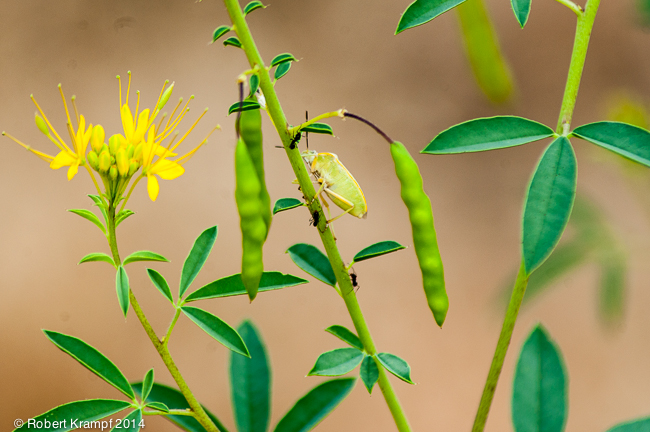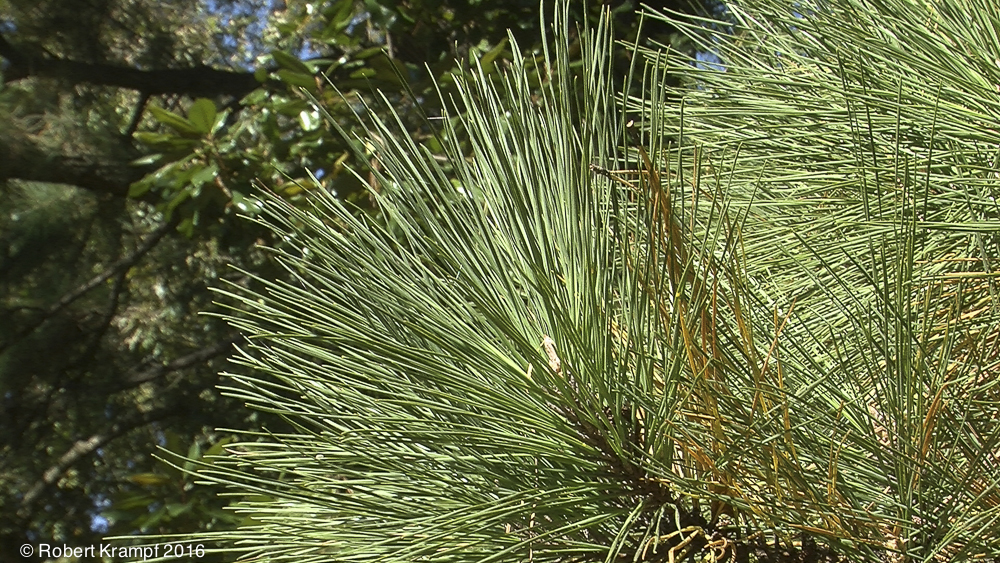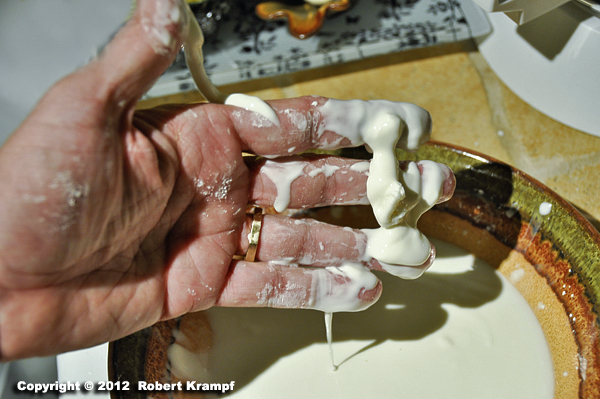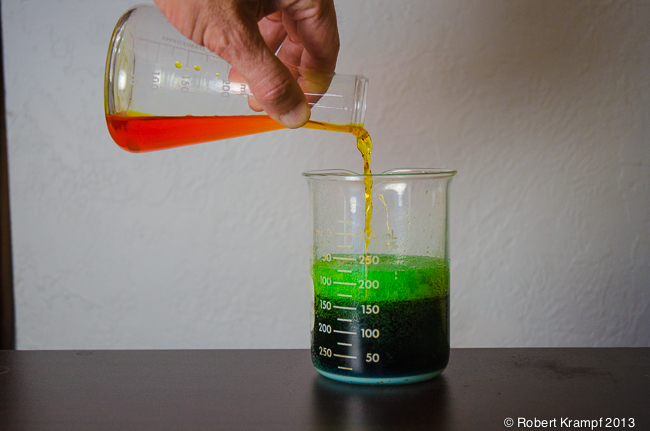Here are some science questions to help you test your general science knowledge. They will also show you which of the Florida, Utah, and NGSS science standards each question is testing.
The questions are chosen randomly, so this quest will be different each time.
Get 5 more random questions.
Would you rather see the most recently added questions?

The large, green stinkbug is drinking sap from this plant. That tells us that it is a:
-
Producer.
No. The plant is a producer. It captures energy from sunlight, and stores it as food. The stinkbug is eating the plant to get that energy. -
Primary Consumer.
Yes! The stinkbug is eating the sap from the plant (a producer) to get the energy it contains. -
Secondary Consumer
No. Secondary consumers eat other consumers. An animal that ate this stinkbug would be a secondary consumer. -
Decomposer
No. Decomposers break down dead and decaying organisms. The plant that the stinkbug is eating is still alive and growing.
Click to see which state standards this question tests, and which of my videos, experiments, and other resources support that topic.
Florida
SC.4.L.17.3 Trace the flow of energy from the Sun as it is transferred along the food chain through the producers to the consumers.
| Secondary Consumers | video, free, ClosedCaptions, Updated, checked |
| Producers | video, free, Updated, checked |
| Primary Consumers | video, ClosedCaptions, Updated, checked |
| Scavengers and Decomposers | video, free, ClosedCaptions, Updated |
| What is a Food Web? | text page, free, checked |
| Food Web Tag | text page |
| Review Food Web-2 | practice |
| Review Food Web-1 | practice |
| Review Food Web-3 | practice |
| Review Food Web-4 | practice |
| Review Food Web-5 | practice |
| Review Food Web-6 | practice |
| Review Food Web-7 | practice |
| Review Food Web-8 | practice |
| Review Food Web-9 | practice |
| Review Food Web-10 | practice |
SC.7.L.17.1 Explain and illustrate the roles of and relationships among producers, consumers, and decomposers in the process of energy transfer in a food web.
| Secondary Consumers | video, free, ClosedCaptions, Updated, checked |
| Producers | video, free, Updated, checked |
| Primary Consumers | video, ClosedCaptions, Updated, checked |
| Measuring Calories | video, ClosedCaptions, checked |
| Scavengers and Decomposers | video, free, ClosedCaptions, Updated |
| What is a Food Web? | text page, free, checked |
| Food Web Tag | text page |
| Review Food Web-2 | practice |
| Review Food Web-1 | practice |
| Review Food Web-3 | practice |
| Review Food Web-4 | practice |
| Review Food Web-5 | practice |
| Review Food Web-6 | practice |
| Review Food Web-7 | practice |
| Review Food Web-8 | practice |
| Review Food Web-9 | practice |
| Review Food Web-10 | practice |
Utah
UT.8.II.2.a Categorize the relationships between organisms (i.e., producer/consumer/decomposer, predator/prey, mutualism/parasitism) and provide examples of each.
| Producers | video, free, Updated, checked |
| Primary Consumers | video, ClosedCaptions, Updated, checked |
| Secondary Consumers | video, free, ClosedCaptions, Updated, checked |
| What is a Food Web? | text page, free, checked |
| Review Food Web-2 | practice |
| Review Food Web-1 | practice |
| Review Food Web-3 | practice |
| Review Food Web-4 | practice |
| Review Food Web-5 | practice |
| Review Food Web-6 | practice |
| Review Food Web-7 | practice |
| Review Food Web-8 | practice |
| Review Food Web-9 | practice |
| Review Food Web-10 | practice |
| Review Food Web-11 | practice |
| Review Food Web-12 | practice |
NGSS
5-PS3-1 Use models to describe that energy in animals’ food (used for body repair, growth, motion, and to maintain body warmth) was once energy from the sun.
| Producers | video, free, Updated, checked |
| Measuring Photosynthesis | video, checked |
| Primary Consumers | video, ClosedCaptions, Updated, checked |
| Measuring Calories | video, ClosedCaptions, checked |
| Scavengers and Decomposers | video, free, ClosedCaptions, Updated |
| Secondary Consumers | video, free, ClosedCaptions, Updated, checked |
| Calories: Measuring the Energy | text page, free |
| What is a Food Web? | text page, free, checked |
| Review Food Web-2 | practice |
| Review Food Web-1 | practice |
| Review Food Web-3 | practice |
| Review Food Web-4 | practice |
| Review Food Web-5 | practice |
| Review Food Web-6 | practice |
| Review Food Web-7 | practice |
| Review Food Web-8 | practice |
| Review Food Web-9 | practice |
| Review Food Web-10 | practice |
5-LS2-1 Develop a model to describe the movement of matter among plants, animals, decomposers, and the environment.
| Producers | video, free, Updated, checked |
| Primary Consumers | video, ClosedCaptions, Updated, checked |
| Scavengers and Decomposers | video, free, ClosedCaptions, Updated |
| Secondary Consumers | video, free, ClosedCaptions, Updated, checked |
| What is a Food Web? | text page, free, checked |
| Review Food Web-2 | practice |
| Review Food Web-1 | practice |
| Review Food Web-3 | practice |
| Review Food Web-4 | practice |
| Review Food Web-5 | practice |
| Review Food Web-6 | practice |
| Review Food Web-7 | practice |
| Review Food Web-8 | practice |
| Review Food Web-9 | practice |
| Review Food Web-10 | practice |

Pine trees do not have flowers. What structure do they have that servers the same purpose?
-
Needles
No. Pine needles are a kind of leaf. They are not used for reproduction. -
Cones
Yes! Pine cones produce pollen and seeds, just as flowers do in flowering plants. -
Fruit
No. Fruit are used for dispersing seeds, not for pollination. -
Buds
No. Pine tree buds produce needles. They are not involved in reproduction.
Click to see which state standards this question tests, and which of my videos, experiments, and other resources support that topic.
Florida
SC.3.L.15.2 Classify flowering and nonflowering plants into major groups such as those that produce seeds, or those like ferns and mosses that produce spores, according to their physical characteristics.
| Pumpkin Guts | video, free, ClosedCaptions, checked |
| Seed Search | video, ClosedCaptions, checked |
| Review Plants-4 | practice |
| Review Plants-8 | practice |
SC.3.L.14.1 Describe structures in plants and their roles in food production, support, water and nutrient transport, and reproduction.
| Measuring Photosynthesis | video, checked |
| Seed Search | video, ClosedCaptions, checked |
| Orange Slices | video, ClosedCaptions |
| Testing a Leaf for Starch | video, ClosedCaptions |
| Flowers | video, ClosedCaptions |
| Heartless Plants | video, ClosedCaptions, checked |
| Pumpkin Guts | video, free, ClosedCaptions, checked |
| Smell the Flowers | text page |
| Review Plants-3 | practice |
| Review Plants-2 | practice |
| Review Plants-5 | practice |
| Review Plants-6 | practice |
| Review Plants-7 | practice |
| Review Plants-8 | practice |
SC.4.L.16.1 Identify processes of sexual reproduction in flowering plants, including pollination, fertilization (seed production), seed dispersal, and germination.
| Seed Search | video, ClosedCaptions, checked |
| Orange Slices | video, ClosedCaptions |
| Flowers | video, ClosedCaptions |
| Pumpkin Guts | video, free, ClosedCaptions, checked |
| Review Plants-2 | practice |
| Review Plants-6 | practice |
| Review Plants-7 | practice |
| Review Plants-8 | practice |
| Review Plants-3 | practice |
Utah
NGSS
4-LS1-1 Construct an argument that plants and animals have internal and external structures that function to support survival, growth, behavior, and reproduction.
| Heartless Plants | video, ClosedCaptions, checked |
| Nature Watching | video, checked |
| Calling a Woodpecker | video, checked |
| Pumpkin Guts | video, free, ClosedCaptions, checked |
| Seed Search | video, ClosedCaptions, checked |
| Orange Slices | video, ClosedCaptions |
| Bird Bones | video, free |
| Feathers | video, checked |
| Thoughts on an Exoskeleton | text page, free |
| Eye Shine | text page |
| How Does a Butterfly Fly? | text page, free |
| Review Plants-3 | practice |
| Review Plants-1 | practice |
| Review Plants-5 | practice |
| Review Plants-6 | practice |
| Review Plants-7 | practice |
| Review Plants-8 | practice |
MS-LS1-4 Use argument based on empirical evidence and scientific reasoning to support an explanation for how characteristic animal behaviors and specialized plant structures affect the probability of successful reproduction of animals and plants respectively.
| Calling a Woodpecker | video, checked |
| Selective Smelling | video, checked |
| Pumpkin Guts | video, free, ClosedCaptions, checked |
| Seed Search | video, ClosedCaptions, checked |
| Orange Slices | video, ClosedCaptions |
| Bacteria and Antibiotics | video, ClosedCaptions |
| Flowers | video, ClosedCaptions |
| Onion Crystals | video |
| A Walk in the Park | video, checked |
| Nature Watching | video, checked |
| Thoughts on an Exoskeleton | text page, free |
| How Does a Butterfly Fly? | text page, free |
| Review Adaptation-3 | practice |
| Review Plants-2 | practice |
| Review Plants-4 | practice |
| Review Adaptation-4 | practice |
| Review Adaptation-5 | practice |
| Review Adaptation-6 | practice |
| Review Plants-8 | practice |

When you mix cornstarch and water, you get something that many science sites call Oobleck. Under pressure, it feels like a solid, but when the pressure is removed, it flows like a liquid. What state of matter is it?
Answer:
This is a mixture, made up of particles of solid matter surrounded by a liquid. The mixture is not a single state of matter.
This is an important concept to understand, and it is seen in many things we use every day. A good example is the Egg States video, showing how a mixture of liquid and gas can seem to be a solid.
Before you try to decide if something is solid, liquid, gas, plasma, or some other state of matter, first make sure that it is a pure substance, and not a mixture of different states.
Click to see which state standards this question tests, and which of my videos, experiments, and other resources support that topic.
Florida
SC.2.P.8.2 Identify objects and materials as solid, liquid, or gas.
| Ice Cream Science | video, checked |
| Raw Egg or Boiled? | video, checked |
| Air Space | video |
| Egg States | video, checked |
| Experimenting with Dry Ice | video, free, checked |
| Teach It Right the First Time. | text page, free |
| Review Matter-3 | practice |
SC.5.P.8.1 Compare and contrast the basic properties of solids, liquids, and gases, such as mass, volume, color, texture, and temperature.
>>> Teacher Page: States of Matter
| Wax and Wood, part 1 | video, checked |
| Wax and Wood, part 2 | video, checked |
| Ice Cream Science | video, checked |
| Raw Egg or Boiled? | video, checked |
| Air Space | video |
| A Bouncing Water Balloon | video |
| Egg States | video, checked |
| Experimenting with Dry Ice | video, free, checked |
| Air has Weight | text page |
| Teach It Right the First Time. | text page, free |
| Review Matter-2 | practice |
| Review Matter-1 | practice |
| Review Matter-3 | practice |
| Review Weather-10 | practice |
SC.8.P.8.1 Explore the scientific theory of atoms (also known as atomic theory) by using models to explain the motion of particles in solids, liquids, and gases.
| Ice Cream Science | video, checked |
| Expansion of Solids | video, ClosedCaptions, checked |
| A Bouncing Water Balloon | video |
| Egg States | video, checked |
| Experimenting with Dry Ice | video, free, checked |
| Review Matter-1 | practice |
| Review Matter-3 | practice |
Utah
UT.5.I.2.a Identify the physical properties of matter (e.g., hard, soft, solid, liquid, gas).
| Wax and Wood, part 1 | video, checked |
| Wax and Wood, part 2 | video, checked |
| Ice Cream Science | video, checked |
| Raw Egg or Boiled? | video, checked |
| Crushed Can | video, checked |
| A Bouncing Water Balloon | video |
| Egg States | video, checked |
| Experimenting with Dry Ice | video, free, checked |
| Review Matter-1 | practice |
| Review Matter-3 | practice |
NGSS

The Earth stays in orbit around the Sun because:
-
The Sun's gravity pulls on the Earth
This is only part of the answer. -
The Earth's gravity pulls on the Sun
This is only part of the answer. -
The gravity of the Sun and the Earth pull on each other
Yes! The gravitational attraction between the Earth and the Sun is a result of both the Sun pulling on the Earth and the Earth pulling on the Sun. -
Gravity does not keep the Earth in its orbit.
No. Without the pull of gravity, the Earth would continue moving in a straight path instead of curving around the Sun.
Click to see which state standards this question tests, and which of my videos, experiments, and other resources support that topic.
Florida
SC.5.P.13.1 Identify familiar forces that cause objects to move, such as pushes or pulls, including gravity acting on falling objects.
| Magic Coin | video |
| Making a Compass | video, checked |
| Torque | video |
| Water in a Glass, part 2 | video, checked |
| Water in a Glass, part 3 | video, checked |
| Water in a Glass, part 1 | video, checked |
| Obedient Coin | video, checked |
| The Slow Race | video, free, ClosedCaptions, Updated |
| Balancing a Meter Stick | text page |
| Review Space-13 | quest |
SC.8.E.5.9 Explain the impact of objects in space on each other including: 1. the Sun on the Earth including seasons and gravitational attraction 2. the Moon on the Earth, including phases, tides, and eclipses, and the relative position of each body.
| Global Science | video, ClosedCaptions |
| Why is a Full Moon So Bright? | text page, free, checked |
| Review Space-13 | quest |
| Review Space-12 | practice |
SC.6.P.13.2 Explore the Law of Gravity by recognizing that every object exerts gravitational force on every other object and that the force depends on how much mass the objects have and how far apart they are.
| Planets and Pennies | video, ClosedCaptions |
| Force, Pressure, and Shoes | video, checked |
| Water in a Glass, part 2 | video, checked |
| Water in a Glass, part 3 | video, checked |
| Water in a Glass, part 1 | video, checked |
| Review Space-13 | quest |
Utah
UT.3.IV.2.c Pose questions about gravity and forces.
| Water in a Glass, part 1 | video, checked |
| Planets and Pennies | video, ClosedCaptions |
| Force, Pressure, and Shoes | video, checked |
| Water in a Glass, part 2 | video, checked |
| Water in a Glass, part 3 | video, checked |
| Balancing a Meter Stick | text page |
| Review Energy-8 | quest |
| Review Space-13 | quest |
UT.6.III.3.a Describe the forces holding Earth in orbit around the sun, and the moon in orbit around Earth.
| Review Space-13 | quest |
NGSS
MS-ESS1-2 Develop and use a model to describe the role of gravity in the motions within galaxies and the solar system.
| Planets and Pennies | video, ClosedCaptions |
| Review Space-13 | quest |
| Review Space-10 | practice |

When a scientist makes a new discovery, other scientists usually do exactly the same experiment. Why?
-
They want to get part of the credit.
No. While replicating an experiment is very important, the scientists who do it usually don't get much credit for their work unless they discover an error in the original experiment. -
Repetition is part of the scientific process.
No. Repetition is when scientists repeat their own experiment several times, not when other scientists do the same experiment. -
They think they can make changes to improve the experiment.
No. By doing exactly the same experiment, they are not changing anything. Instead, they are replicating the experiment as closely as possible. -
Replication is part of the scientific process.
Yes. By replicating the experiment, other scientists can help verify that the results are accurate. There is always a possibility that there was some unnoticed influence on the original experiment, and replication can help spot that.
Click to see which state standards this question tests, and which of my videos, experiments, and other resources support that topic.
Florida
SC.2.N.1.4 Explain how particular scientific investigations should yield similar conclusions when repeated.
| What is Science? | video, ClosedCaptions |
| Review Scientific Process-10 | practice |
| Review Scientific Process-6 | practice |
| Review Scientific Process-5 | practice |
| Review Scientific Process-7 | practice |
SC.5.N.2.2 Recognize and explain that when scientific investigations are carried out, the evidence produced by those investigations should be replicable by others.
>>> Teacher Page: Nature of Science and Dissolving
| What is Science? | video, ClosedCaptions |
| What is Science?: Repeat and Replicate | video |
| Review Scientific Process-10 | practice |
| Review Scientific Process-6 | practice |
| Review Scientific Process-5 | practice |
SC.6.N.1.2 Explain why scientific investigations should be replicable.
| What is Science? | video, ClosedCaptions |
| What is Science?: Repeat and Replicate | video |
| Review Scientific Process-6 | practice |
| Review Scientific Process-5 | practice |
SC.7.N.1.2 Differentiate replication (by others) from repetition (multiple trials).
| What is Science? | video, ClosedCaptions |
| What is Science?: Repeat and Replicate | video |
| Review Scientific Process-6 | practice |
| Review Scientific Process-5 | practice |
SC.8.N.1.2 Design and conduct a study using repeated trials and replication.
| What is Science?: Repeat and Replicate | video |
| Review Scientific Process-6 | practice |
| Review Scientific Process-5 | practice |
| Review Scientific Process-7 | practice |
| Review Scientific Process-10 | practice |
Utah
NGSS
The questions are chosen randomly, so this quest will be different each time.
